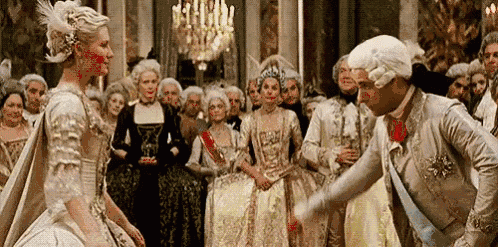Today, 14 July, is the national day of France. It commemorates the storming of the Bastille on 14th July 1789, which kicked off the French Revolution.

Every year, a military parade is held to pay tribute to this symbol of freedom and revolution. Also the people of Paris warmly celebrate and enjoy firework shows on this day.

The French Revolution was a big challenge to many of the traditional rituals of the time. This week, let's take a look at the major differences in etiquette before and after 1789.
Kissing or handshaking?

Kissing as a greeting has a long history in Europe, with the ancient Greek writer Herodotus depicting such greetings as early as 500 BC. Later, the upper classes were more likely to express their loyalty to each other by kissing hands in medieval France. The handshake was more common in France at the time.

It was not until after the French Revolution that "la bise", or cheek-kissing, was revived. This was considered to be more on line with the maxims of liberty, equality and fraternity mentioned in the Declaration of Rights of Man and of the Citizen.
Only two meals per day?

Luncheon in the bedroom of the king Louis XIV (Jean-Léon Gérôme,1862)
It is interesting to note that before the 18th century, the French people ate only two meals a day. The first meal was eaten between 10AM and 12AM, and the second around 7PM.

"Le déjeuner d'huîtres" - Jean-François de Troy, 1735
Afterwards, with the industrial revolution, more and more of the French working class were engaged in the busy work of production and a breakfast provided them with sufficient energy. Simultaneously, dinner was postponed to 8PM-9PM. This is one of the main reasons why the French have late dinners today.
Using hands instead?

Although the fork was invented around 350 AD in Constantinople, its popularity in France was a long way off. It was considered a dangerous item by the bishops of the time, so it was more common for the royal family as well as the ordinary people to use their hands to eat.

The French Revolution overthrew feudalism and a series of movements gradually liberated the mind, and the evil perception of the fork gradually changed and it is still the norm today as a practical dining tool that is always combined with a knife.
The minuet or the waltz?

Most of the popular ballroom dances of modern society have evolved from court dances. The establishment of the Royal Academy of Dance in 1661 by Louis XIV, led to the gradual standardisation of court dances, which did not begin to take shape until after the 17th century. Before the Revolution of 1789, the minuet was the most representative court dance, popular among European royalty.

With the Revolution, the changing of social environment demanded a more liberal and joyful approach to dancing. The waltz became a new favourite and a way for the French to express their confidence and freedom. Nowadays, the spirited latin dances such as salsa and tango are also very popular.
How luxurious was the dressing?

Marie-Antoinette, Queen to the King Louis XVI
Before the end of the 18th century, the dress code of French upper classes was in the most extravagant way. Even a merchant's wife could be dressed as a noblewoman if she had the enough money to do so. The more exaggerated hairstyles and flamboyant dresses were the aristocrats' response to the lower classes challenging their status.

After 1789, simplicity became the first priority in the dress code for the French people of the time. Women abandoned fancy dresses and would also express their political aspirations subtly through their clothes (using red, white and blue). For men, exaggerated wigs were abandoned in favour of darker shades and practical clothes.
The heyday of salon culture?

The salon culture was one of the most beautiful features of 18th century French history. The Renaissance gave further impetus to the development of such gatherings. In the salons, people were free to discuss and criticise art and literature, regardless of their gender or age. All outstanding individuals, both men and women were treated with the same level of respect, which was rare in a France that was still under feudal rule.

After 1789, however, the discussion in the salons gradually shifted from the literary to the political sphere. The post-Revolutionary salons changed from a pluralistic to a monolithic and closed nature, both in terms of participants and the format in which they were held, and were more of a formality than anything else. To this day, cultural salons still exist sporadically, but the prosperity of the time has long since been lost.

After looking into the history of France, we can't help but think that while etiquette has continually evolved and sometimes been challenged over the years, it is still today an essential part of our society. On that special day, let us say "Vive la France !"

Founded in 2018 by Matthieu Ventelon, Hedonia is the first institution in China combining professional Wine and Etiquette expertise in the same training offer.
Find more information on our website : http://en.hedonia.cn